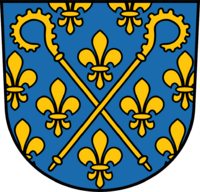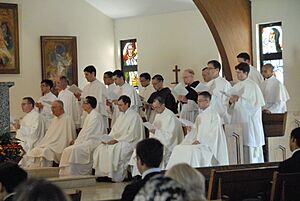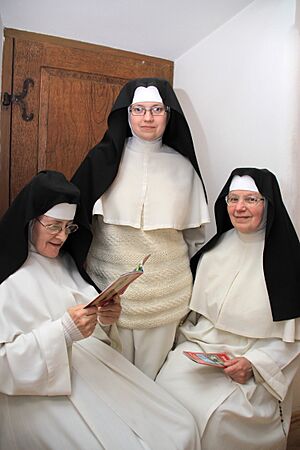Premonstratensians facts for kids
|
Candidus et Canonicus Ordo Praemonstratensis
|
|

Shield of the Premonstratensians
|
|
| Abbreviation | OPraem |
|---|---|
| Formation | 1120 |
| Type | Catholic religious order |
| Headquarters | Viale Giotto, 27, 00153 Rome, Italy |
| Location |
|
|
Region served
|
Worldwide |
|
Membership
|
1600+ (2024) |
|
Abbot General
|
Josef Wouters |
|
Main organ
|
General Chapter |
| Affiliations | Catholic Church |
The Order of Canons Regular of Prémontré, often called the Premonstratensians or Norbertines, is a religious order in the Catholic Church. In Britain and Ireland, they are known as the White Canons. This name comes from the white color of their special clothes, called a habit.
The order was started in 1120 by Norbert of Xanten in a place called Prémontré in France. Norbert later became an important leader in the church. Members of this order use "O.Praem" after their names. They follow the traditions of Saint Augustine.
Norbert was a friend of Bernard of Clairvaux. He was inspired by the Cistercian way of life. Unlike monks, Premonstratensians are "canons regular." This means their work often includes preaching and helping people in churches. They frequently serve in parishes near their main homes, called abbeys or priories.
Contents
History of the Norbertines
How the Order Began
The Premonstratensian order started in 1120. Saint Norbert had tried to bring a strict way of life to other groups of canons in Germany. In 1120, he was working in France. There, in a rural area called Prémontré, he and thirteen friends set up a monastery. This became the first home of their new order.
Because they were canons regular, they followed the Rule of St. Augustine. They also had extra rules that made their lives very simple and strict. Daily prayer and celebrating the Eucharist (a special church service) were very important to them.
Growth Across Europe
In 1126, the Pope officially approved the order. At that time, they had nine houses. Many more were quickly built across Europe. By the mid-1300s, there were about 1,300 monasteries for men and 400 for women.
The Norbertines played a big part in bringing Christianity to new areas. They helped convert the Wends and spread the Christian faith around the Elbe and Oder rivers. Over time, some rules became less strict, leading to new groups within the order.
Norbertines in England and Beyond
The Norbertines arrived in England around 1143. Their first house was in Newhouse, Lincoln, England. Before King Henry VIII closed many monasteries, there were 35 Norbertine houses in England. They also founded Dryburgh Abbey in Scotland and other communities there.
Like most religious orders, the Norbertines faced many challenges. They were almost completely destroyed by events like the Reformation and the French Revolution. However, they experienced a strong comeback in the 1800s.
By the early 1800s, only eight houses remained, all in the Habsburg monarchy. But the order grew again. By the early 1900s, there were 20 monasteries and 1,000 priests. As of 2005, the number of monasteries had grown to nearly 100, spreading to every continent.
In 1893, Father Bernard Pennings and two other Norbertines came to the United States. They came to help Belgian immigrants in Wisconsin. De Pere, Wisconsin became the site of the first Norbertine Abbey in the Americas.
What Norbertines Do
As canons regular, Premonstratensians have always been involved in helping people. They run retreat centers and care for pilgrims. Like many religious houses, they have often run schools of different sizes.
To support themselves, their communities have also run small businesses. These include printing, farming, forestry, and making cheese. They have also worked with breweries and done artistic bookbinding. Some have even run astronomical observatories.
As of 2024, there are over 1,600 members in the order. The Feast of All Norbertine Saints and Blesseds is celebrated on November 13.
The Norbertines have also had a big presence in Green Bay, Wisconsin. They used to own TV and radio stations there. They ran two local boys' high schools until 1990. Today, they still run four local schools in De Pere and Green Bay. One of these is St. Norbert College, which is the only Norbertine higher education school in the world.
Norbertine Canonesses
The Norbertine Order also has several abbeys for women. These women are called canonesses, but they live a life similar to nuns. They live in an enclosed religious order. Like the men's communities, each women's community is independent.
It is special within the Catholic Church that the Norbertine Order has always seen the spiritual life of the canonesses as just as important as that of its priests and lay brothers. In the Middle Ages, some Premonstratensian monasteries were "double monasteries." In these, men and women lived in separate areas next to each other but shared the same church building. Today, women's communities often have connections with other canonesses and with communities of canons.
Norbertine Worship Style
The Premonstratensians were one of the religious orders that had their own special way of worship, called a rite. They kept this rite even when many others were stopped by the Pope. The Norbertine Rite was known for its very serious and formal ceremonies.
This rite also focused a lot on the Paschal mystery, which is about Jesus' death and resurrection. This was especially clear in how they celebrated daily services during the Easter week. Their evening prayers (vespers) ended with a procession to the baptismal font. Another unique practice was celebrating a special Mass every day in honor of the Virgin Mary in each of their abbeys.
How the Order is Organized
Norbertine abbeys and most priories are independent. This means their daily practices and work can be different. They adapt to the needs of the local church. Some houses focus on quiet prayer, while others are very active in helping people.
However, every house follows the Rule of Saint Augustine. They also follow rules set by the General Chapter, which is a big meeting held every six years. This General Chapter includes representatives from both male and female communities.
The head of the Order is called the Abbot General. He lives in Rome. He gets help from a High Council and other groups that deal with different parts of the Order's life, like worship and communication between abbeys.
Norbertine Abbeys Around the World
As of 2012, there were Premonstratensian abbeys or priories in many countries. These include Australia, Austria, Belgium, Brazil, Canada, Czech Republic, Democratic Republic of the Congo, Denmark, France, Germany, Hungary, India, Ireland, Italy, Netherlands, Peru, Poland, Romania, Russia, Slovakia, South Africa, Spain, Switzerland, United Kingdom, and the USA.
The Order is divided into seven main regions, called circaries:
|
Anglica Circary
Bohemica Circary
Brabantica Circary
|
Gallica Circary
Germanica Circary
Hungarica Circary
Portuguesa Circary
|
Famous Norbertines
Many people have been part of the Norbertine Order. Here are a few notable members:
- Robert John Cornell (1919–2009), a U.S. Congressman and professor.
- Prokop Diviš (1698–1765), a Czech inventor.
- Hermann Joseph (1150?–1241), a German mystic.
- Werenfried van Straaten (1913–2003), a Dutch priest known for his humanitarian work.
- Johann Zahn (1631–1707), a German canon who wrote about the camera obscura and invented an early camera.
Norbertine Saints and Blesseds
Norbertines celebrate "all Norbertine Saints and Blesseds" on November 13.
- Norbert (died 1134, feast day June 6)
- Hermann Joseph von Steinfeld (feast day May 24)
- Adrian and James of Middleburg, martyrs (died 1572, feast day July 9)
- Evermode of Ratzeburg (died 1178, feast day February 17)
- Frederick of Hallum (died 1175, feast day February 4)
- Isfrid of Ratzeburg (died 1204, feast day June 15)
- Siard of Mariengaarde (died 1230, feast day November 14)
- Bronislava of Poland (died 1259, feast day August 30)
- Gerlach of Valkenburg (died 1172, feast day January 5)
- Gertrude of Aldenberg (died 1297, feast day August 13)
- Jakob Kern of Geras (died 1924, feast day October 20)
- Peter-Adrian Toulorge, Martyr (died 1793, feast day October 13)
Norbertine Schools
St. Norbert College in De Pere, Wisconsin, United States, is the only higher education school sponsored by the Order. In other places, they also sponsor or run schools, or help out in parish schools.
Schools founded or sponsored by the order include:
- Abbot Pennings High School, De Pere, Wisconsin, US (now part of Notre Dame Academy)
- Archmere Academy, Claymont, Delaware, US
- Cardinal Gracias High School, Bandra, Maharashtra, India
- St. Michael's Preparatory School, Silverado, California, US
- St. Norbert College, Perth, Western Australia
- Saint Norbert Gymnasium, Gödöllő, Hungary
See also
- List of Premonstratensian monasteries in France
- Category:Premonstratensian monasteries in England



